Then there is that other, coarser reality of Paris, away from the tourism propaganda. This is the Paris of social divisions, of joblessness and anomie, of ethnically marked ghettos and banlieues. The paranoid Paris of serial muggings and terror attacks and pickpockets on the Metro. How is one to escape all that? As the public-service announcements would have you believe: by avoiding the no-go areas; by being alert; by keeping your eyes open. But at times, it makes more sense to avert your gaze. As when you see that woman begging for money at a train station, with two kids in tandem, approach you. Don’t look at her, nor at the cardboard placard she’s carrying, which reads, “Syrian Family”.
I saw another, bigger family sitting on a pavement outside a bank somewhere in the 10th Arrondisement. Were they refugees, or gypsies? I don’t know. The five of them—three kids, a woman and a man—all sat together in a row, each with their back against the wall. Sheets of foam rubber were placed under them, and a blanket covered their legs. It was as though someone had arranged them in this order for a family portrait. They would have looked just as much at ease lounging in a bedroom before a TV set.
This is the detritus of Parisian society, the rejects, and they are everywhere. On our first day in Paris, my wife and I were denied an early check-in by the hotel staff. We had a few hours to kill. And so, while roaming around the neighbourhood, we both felt at one with, and—after an overnight bus journey from Berlin—perhaps even looked a little like, the homeless of Paris. At the Boulevard de Magenta, as we sat in an al-fresco cafe, we were confronted by a man brandishing an iPhone. He was offering to sell it to us. When we waved him away, we expected something more sinister in his wake, like a whole gang of street toughs. We expected something more hopeful, too, like a police siren. Thankfully, none arrived.
Emergency sirens are a big part of how I experience European cities. That dilated wail boomeranging across a space here is so different from what we have in India. It signifies urgency, panic. On a busy day in Paris you can hear the sirens go off every few minutes. A sign of how responsive the city’s emergency services are. Also of how someone, somewhere is always going to hell.
The police presence, though, is just one part of the scenery. All prime locations in the city are, by default, high-value targets, some of which are guarded by military personnel armed with assault rifles. I thought the personnel, the rifles, all fitted well in this setting, if one bears in mind the larger historical context. Those clichés about love and light surrounding the idea of Paris often obscure the fact that this is a city enamoured of its martial past. The monuments—Arc de Triomphe, Les Invalides, Place Vendôme—all serve to reinforce that Old-World link between personal glory and the battlefield. It’s clear that the military might of the republic is both a historical and a contemporary conceit.
Away from the tourism propaganda, exists the crude reality of Paris. This is the Paris of social divisions, of joblessness and anomie, of ethnically marked ghettos and banlieues.
While crossing the street one day, I was left stunned by a sight that seemed to have lasted for barely a second. An immense wave of noise and movement and colour had filled the sky. We’re under attack, was my first thought. Everything on the ground had come to a standstill. It took me some time to regain my senses and to register the vapour trails of the five fighter jets that had just screamed by not far above us. We later found that it was a ceremonial fly-by, to mark the proceedings of Tour de France, being hosted in the centre of the city. The vapour trails were the colours of the French flag: blue, white and red.
But this pomp and glamour is not what the Paris of my imagination is about. The colour that comes closest to capturing the city’s spirit, for me, is what Saul Bellow called “the dogged northern gray, the native Parisian grisaille” that most buildings here are still painted in. In the late ’40s, Bellow spent a few years in Paris thinking and writing about America (he wrote The Adventures of Augie March here). Bellow was, as he wrote, among those “eager travelers, poets, painters and philosophers… sentimental pilgrims” who’d made a beeline towards Paris after the end of the Second World War. All were chasing the city of their imagination. Some never found it, while others did.
Among this last group of sentimental pilgrims was the American writer Susan Sontag, who first came here in 1957. She made Paris her second home and also, as I discovered, her final resting place. The Montparnasse Cemetery is where some of the city’s greatest literary icons are buried. Sartre is here, so is Baudelaire, Maupassant, Beckett and countless others. A large hoarding at the gate displays the map of the property. The graves are numbered and indexed against the names of the famous dead on this map, but Sontag’s name is not mentioned anywhere.
So I had to spend some time looking for her. Walking around these plots, navigating this great labyrinth of death, can be distressing
“I felt the city,” Sontag once said about Paris. But I guess she was talking about the Paris of her imagination. And I am talking about the Paris of mine, where I saw more light than love.

